In sales enablement and training, and development generally, finding the resources and investment needed for our important work can sometimes be challenging, it can feel like an uphill battle.
In this article, I’ll discuss org design and specifically restructuring sales enablement to mimic a traditional product dev team.
Specifically, the piece will focus on:
- How to use product development best practices to develop sales enablement
- The role of various teams, such as:
3) LXD/ID
This will help build the sales enablement organization in a way that makes accessing investment dollars based on proven outcomes achievable and maximizes your impact.
Using product development best practices to develop high impact sales enablement
The agenda
What I’m going to discuss in this article is:
- Forming your enablement team, and
- Using product development best practices to develop high-impact sales enablement.
I really hope that you get some fun ideas, tips, and tricks that you can quickly apply, and ways you can form your teams around positive ROI.
The objective of this article is to help you get the investment and resourcing to maximize your impact.
Often when you walk into a new enablement team the way they know they’re important, or they’ve had an impact is due to a level one survey telling them 'high five you're doing a great job', (and they likely worked 60 to 70 hours a week just to get the work done).
I want us to figure out how to maximize the time of our people, maximize their impact, and then give them time back to relax and come up with new creative ideas to help advance our sales teams.
The problem
The problem we're dealing with today is enablement is a historically under-resourced team - of course, we know it's vital to sales success - for a few different reasons.
- Because it's hard to show ROI.
- Because the impact is often dispersed across multiple actors and multiple teams, it's really hard to isolate the variable of training, or tools that we support, and say this is the one reason why sales increase their numbers.
- We're often considered to be a support or administrative resource.
I want to change that within sales enablement, within sales productivity, I think it's important we become an ideal partner, and we become a partner that actually delivers money back to the business.
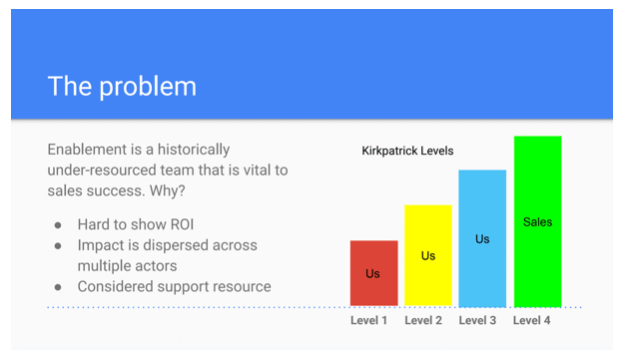
Kirkpatrick levels
On the right-hand side you can see the Kirkpatrick levels of measurement, you probably already know these, but just to give you a general overview:
- Level one - the smile sheets at the end of all the training classes you do, the things that we ask, 'would you recommend this class, do we give you a high five or not a high five?' and some gentle expository feedback.
That's important for us to know, and to see the quality of presentation but it also helps us develop the next level of content based on feedback from our customers that is important for us but maybe not as important to the business.
- Level two of course means that they've acquired knowledge, they can pass a quiz, they may be certified on an action.
Also very important, because we think we know best practices very well and the best practices that we know, we want to make sure people understand so that they can get to...
- Level three, which is direct application. Again, that's only important to us, it's important to us that they have application steps and they push things forward, and they utilize best practices that are both learned and new and experimental in many cases because it allows us to know that the work we're doing has an outward and immediate impact first.
But what's most important to the business and the most important to your sales organization is level four.
- Level four - our ROI impact. We do have to have levels one, two, and three to prove level four. Level one and level two show absorption, knowledge, and happiness. Level three shows the adoption of that.
Level four shows the measurable impact of those things.
The solution
What I'm going to move into here is a discussion about:
- How do we provide measurable impact back to the business?
- How do we develop and grow our teams in ways that push towards a measurable impact on the business? So that we can say, “Look, by speeding up X we saved you 90% of some key metric over the last three months”.
We want all of our programs to be measured that way, to be continuously improving that way, and to be developing new skills not only for our people but for the salespeople that we're supporting.
But in order to get to that and solve that problem, we have to develop learning-enabled solutions that have clear ROI drivers for the business and we want to set up teams to deliver the products that will enable that.
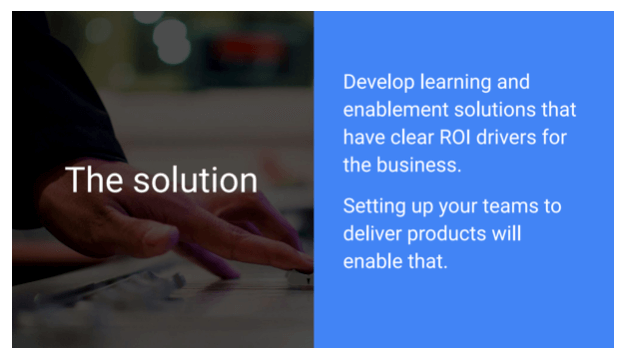
How did I come to the idea?
Let me introduce myself
I have had quite a few different roles in sales organizations and developmental organizations.
Salesperson
First, as a salesperson where I sold learning and development products for two different organizations that are old, old, old school - the old man down by the river, making a hype speech, that's exactly what I sold at the beginning of my sales career working for a company called Fred Pryor Seminars, and National Seminars Group.
Sales manager and director
I did lead and direct teams and sales leaders for both Dex media and Info USA.
Learning programs manager
I was a learning programs manager running onboarding, competency development, leadership development, and a whole bunch of other things for two different places at a small little startup you may have heard of called Amazon, Amazon Local, and Amazon business.
Product manager
Then I took a major shift in my career. I wanted to try something new, and see what it was like to really invent something and get it launched across an organization.
I pivoted into a role as a programs and product manager in the human resources space. I helped develop a launch planning tool that was predictive for all new hires across Amazon and lived within the HR realm.
I actually acted as the business voice and what I learned was acting as the business voice and working with technical voices. I thought I knew everything about how to speak tech, but I didn't. It became very important for me to identify “how do I get the right support resources so that I can work with my technical resources so we can come to the exact same end?”.
I was great at providing the vision, the structure, the documentation that would help guide our technical people to develop, but I wasn't as good at helping them understand the problems, design issues, and the things we needed to solve to make it usable, adaptable, iterative, and improvable across.
I learned a tonne as a product manager, I never want to do it again, I'm done with it. I really love the learning space a tonne; I'm very happy that I had the product manager role in my past because it allowed me to understand there are best practices, there are structures that will help us develop products that deliver real ROI to our teams.
If we can mimic that same structure product development teams have with our sales enablement teams, then we can start providing positive ROI for the business and hopefully then get more investment so we can continue to expand and develop the products and programs we know have great impact and we love.
Global Head of Sales Productivity and Enablement
That got me to where I am today, Global Head of Sales Productivity and Enablement at Square, I've been here just over a year, brought a team that probably feels familiar to a lot of people who handle a lot of things, a lot of one-off requests, a lot of training pieces, mostly on the onboarding.
No one knew where that timeframe went and we have restructured the team around the core tenants of a product development team, looking to get the same ROI and investment that I'll talk about that I hope your teams can get so that we can invest even deeper into the programs that we know have a great impact.
What do I know?
What I know today is product teams tend to have four different roles included in them, they're trying to answer the question of what products are customers trying to buy?
Product teams
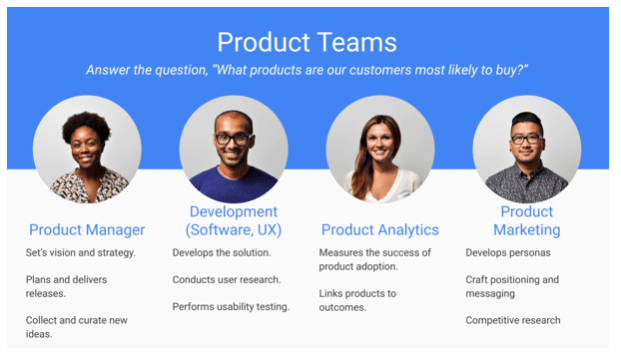
Product manager
They're the person who sets vision and strategy, plans and delivers releases, curates new ideas, and builds backlogs of things that are improvements to current products or development of brand new products.
Development
They work typically hand in hand with development resources that both do software development - software development engineers or SDEs - and UX designers, people that do the user experience of what you're providing.
They're the developers of the solution, they do conduct user research, they perform usability testing to make sure things are used. Both are very, very important.
You've got the business directional person, and then the person who is the builder of that business directional tool, things that are very, very important to develop anything.
The person who tends to sit between those two in a product development team might be someone who's a technical product manager or a technical programs manager, who helps translate the business to the tech and then the tech back to the business.
That's actually where I see leadership sitting in a lot of ways in our organizations. But there are two other really important roles within a product to make sure they get adopted and iterated on and developed, and that people love them and want them.
Product analytics
The first one is product analytics. Product analytics is very important because it measures the success of the adoption of your product, you link products to outcomes, you actually can develop ROI based on customer adoption of specific products.
It's really easy, for instance, at Square, that if someone adopts a Square POS, for us to link the amount of credit card processing that they're utilizing to the POS systems, and develop and identify the margins based on each of those individual products.
We can then tell the business community, here's how much you can expect us to make based on the launch of this new product.
Product marketing
The last group is product marketing, the group that develops personas, crafts positioning and messaging, and helps develop competitive research within the organization.
You've probably worked with these people in sales enablement, these are the ones that probably develop your messaging that you then deliver back out whether in product changes, or a new hire onboarding, for the products your people sell.
You may work hand in hand with them, they may even provide your pitch decks or one-pagers - the important things people then deliver and utilize with their customers specifically.
Those four roles are very, very important.
Enablement teams
In the next image, you're going to see very little has changed, except for some titles that should feel very familiar to you.
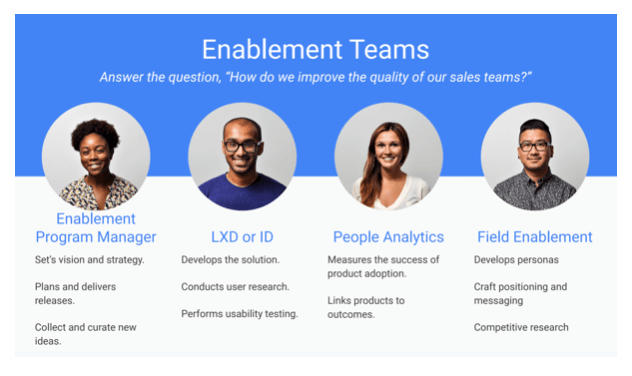
Enablement program manager
First off, I think we should be creating the business voice for all organizations around this idea of a sales enablement or a training program manager.
What that means is the most important programs we have, have a specific manager who sets vision and strategy, creates new ideas, and plans and delivers releases. Sounds very familiar as a product manager might do.
It's exactly what I think the program manager should do. They should think of each individual learning integration they're helping to develop as a product they have to sell to the sales team. The sales team has to adopt it, buy it, and then expand it so that we can prove ROI.
LXD or ID
The second group was both UX and software development, previously for us is the learning experience design or instructional design.
Of course, these are the people that develop the solutions, conduct user research, perform usability testing on the content as it's been developed, often does some level of analysis to make sure that we understand deep enough the problems that we're trying to solve, looks to design and develop the solutions, will then help implementation and then builds in the evaluation pieces that will help then iterate on the programs and make them better.
Those two work side by side to create, but they should be leaning in and working very strongly with their people analytics function.
People analytics
The people analytics function will measure the success of product adoption, links product outcomes directly.
Think about this, if you could tell me your onboarding programs saved your business $1.6 million by shortening time to ramp by one to two weeks over the course of a year, would that be helpful for you to get investment? I think so.
The person that helps you do that directly is your people analytics lead. They help you dive into the data and help you understand what the levers are that you push to make the most money for the business.
Field enablement
The last step is field enablement, again, develops personas, crafts positioning and messaging, and does some level of competitive research.
This role is the person that helps develop strong pitch decks, builds the testimonial loops with the product marketing managers to make sure that it fits into an entire product suite.
Field enablement might own the knowledge catalog that you have, a lot of people use tools like Guru to be a knowledge catalog within their business, the field enablement manager will make sure the Guru cards or that knowledge pieces are:
- Up to date,
- On a specific cadence,
- Verified well.
But then will also create the content and the pieces that get sent directly to your customers, that help push them towards closing faster, and works directly with people analytics to make sure that the content works very well, works as part of a package with enablement program managers.
If you're launching a new product they're building a major part of that new product. If there is a new launch that requires instructional design or learning experiences they're gonna work very in-depth with building those packages too so that when your new launch happens, people are prepared and ready to go.
You can see that those two teams feel very similar and work together collectively to prove ROI for the business and do it very well. Now I'm going to talk about each of these roles specifically, and how they do work together, and what their steps might be.
Sales program manager
A sales enablement program manager is looking to work with people analytics to identify significant gaps in performance. I'm sure you have KPI measurements that you look at all the time and wonder:
- What kind of effect can I have directly on these KPI measures?
- Is there a learning intervention that I can prove actually has an impact?
Hopefully, there is because then in step two, when you develop the analytical frameworks and build program requirement documents to work with your step three learning experience or instructional designers resources to develop solutions, you're building a whole case and you're able to document and prove, 'if we are at X, here's our bet, we will get to Y and it'll take us six months to get there'.
Now you can measure the impact and show it directly to your leadership teams.
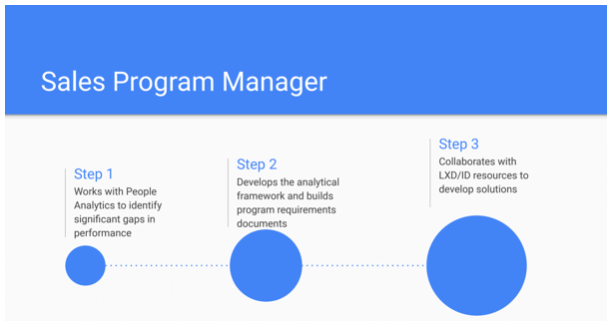
LXD/ID
Learning experience designer and instructional design work with the program managers to determine developmental needs will often work with field enablement to identify voice and persona that we will utilize to develop those learning integrations.
Finally, will develop and launch learning engagements using the learning management system.
I'm actually a big fan of the instructional designer or the instructional design team owning the learning management system as they are the ones that tend to do the inputs, will need to set the structures by which we then get reporting outward, and will feel very tied to that reporting and help them prove not only the adoption cadence but then work with the business case people to prove the ROI cadence of the systems and the training that we build.
Give them a little bit of an extra buy-in, if they've got the tool that they own, that they can then help improve upon and they can annually go and purchase where necessary if needed.
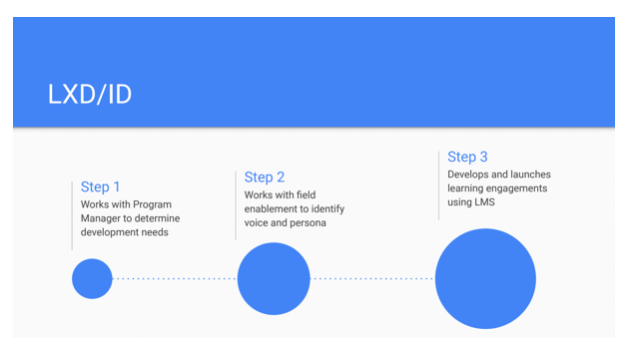
People analytics
People analytics will work with sales strategy to identify inputs. Often they work with the operations team and they'll work with program managers to identify strategies for improvement.
Finally, report outcomes and identify new gaps. In my world that would mean give me a looker dashboard for everyone and everything. For you, it might be a Tableau dashboard for everything you're doing or a way to link ROI directly to the interventions that you're creating.
Their output should be that you or the business person or the sales enablement program manager has clear identification of goals and can easily report back to the business, 'here's how we're growing'.
They will also be able to keep an eye on content and say, 'Enablement program manager, it seems like in week six, we've had a slight dip. This is concerning because of A, B, and C'.
Now we can go and have quick interventions in the middle of a programming sequence and say how do we improve things so that we don't have failure, especially on things that we develop for the long haul?
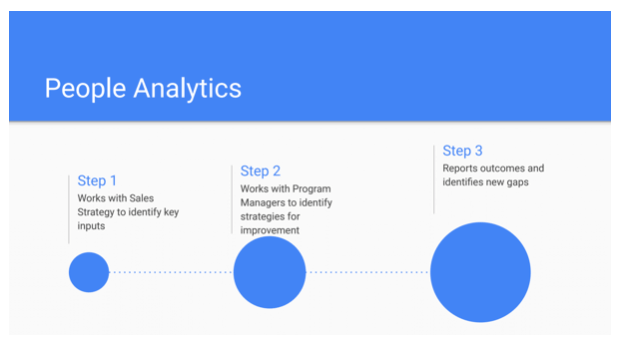
Field enablement
Field enablement, of course, identifies voice and persona for clients, they're doing some of that marketing backend work that really helps especially at the top of the funnel, they'll develop standards and strategies for sales facing content, helping them to build, enable, and drive that content to people and get it launched, and continue to iterate on it.
They're going to collaborate with LX and ID in the creation of voice and direction of assets, often owning what's called a content management system, or CMS.
This will tell them what content is being used well, it will also give eyes into what content when delivered actually moves things through a funnel faster, which again, provides much stronger ROI input because we can say if things move faster, and people can contact more of our merchants that we want to buy from us, then we have X ROI on the back end.
Again, building it from that case of I want to make the company more money, I want to make our business more money so that we get additional investment, so we have more people who can develop content for us, a CMS tool is really key to doing that so that a field enablement person can prove their worth and grow.
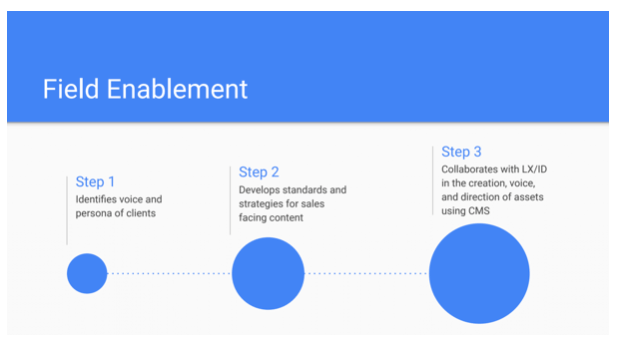
Example programs
Now I'll briefly walk through some examples of programs you probably use today that can fit this criteria and the people who I've discussed and their roles today, you can see how they can collaborate.
Onboarding
The first one is new hire onboarding, I think we all handle this. It's the thing that we're known for. It's the piece that everyone says is the most important driver of the business that enablement can provide.
I don't necessarily think that's wrong. I also think it's the easiest way to prove ROI.
People analytics
People analytics is going to help you define time to ramp metrics and goals. For instance, a lot of businesses use ROI payback as a metric for how successful their hires are, meaning how quickly does a salesperson pay back their entire salary in their first year?
Sometimes it's three months, six months, nine months, 12 months depending on the indicators and how quickly you can generate and find profit from a salesperson. The best thing we can do as an onboarding organization is say, given the programs and the changes we can make to absorbing knowledge, we can make that shorter by one, two, three weeks.
You can extrapolate that over a number of people, and the amount it costs to input that number of people and say, “Now we've saved the business X number of dollars”.
People analytics will be that team to help you identify what those numbers are.
Sales program manager
The program manager will then develop a content and experiment backlog for key strategies to improve those metrics, and hopefully report at least quarterly on the achievements.
Anyone who has ever been near Amazon read about Amazon or understands Amazon, will know that writing documents or quarterly program reviews is very important for the business and for leaning in and meeting specific metrics.
My team is now doing that too. We're doing quarterly program reviews where we show the business quarter over quarter how we're improving key metrics that are inputs to direct ROI.
LXD/ID
You work with instructional designers and learning experience designers to develop and launch content that supports the specific strategy, you get the voice and all of the important things there.
Trainer
Lastly, notice the trainer here, not a role I had above. To me, they report to this specific program manager because they're tied directly to the program and they complete instructor-led training and administrative tasks where necessary to complete the program.
You may have 1, 2, 3, 4 trainers doing it. I actually also think that it's very important that the trainer owns the training. A lot of people work with experts in the field for training and there is a problem with that.
- Experts in the field often know more than anyone in the audience should know. They will go too deep into the content. A trainer who understands the depth of the content is way more effective than an expert in the field who's telling you everything about the content and you're remembering 5-10%.
I do recommend hiring them directly for programs like onboarding if you're large enough.
Enablement tools
A lot of enablement teams own tools - what I mean by that is CMS tools, LMS tools, conversational intelligence tools, cadences, and dialing tools.
Sales program manager
Here you would also have a program manager who develops the success factors and a backlog of improvements or replacements for those tools on an annual basis.
Things like, does our dialer show me that specific cadence leads to more top-of-the-funnel fill? Or does a specific email cadence and a specific email wording tell me that people are more likely to set an appointment with me? Super important top of the funnel pieces.
People analytics
You'll work with people analytics to develop the success factors and reporting.
Field enablement
Finally, you'll work with field enablement, because they develop the key content for the tools, including things like email cadencing, messaging, pitch decks, testimonial cases, new product info, etc.
It should be a team that works together that is reporting improvements and success factors with the tools and showing how things are improving per tool individually.
Competency development
I think this is super important. It's the thing that ties skill back to ROI and it's something you have to consistently work on.
Sales program manager
A program manager in competency development works to develop the competencies per role, builds the improvements that tie those to KPIs.
Very specifically, if you have 'overcoming objections' as a key competency for an account executive, and you think that means time to close or through stage four of the funnel happens faster, that you're identifying that metric and you're measuring specifically how quickly a new way of overcoming objections will help them move metrics faster.
People analytics
They'll work with people analytics to set reporting cadences and dashboard views of competencies and KPIs.
Ongoing learning
Sales program manager
I know that building a learning platform for people to use throughout their careers is becoming more and more important, and we do know that a program manager will help develop the process cadence KPIs for ongoing learning.
In my team, we're developing self-service catalogs and seeing how often people go and utilize them.
People analytics
We also think that people analytics will develop reporting and improvement for cohorts specifically. If we know a group that has gone through a specific program of training now we can link to what for us, their profit impact is three months down the road, especially if it's something that we can now verify they're actually applying and we can see ROI from.
LXD/ID
Your learning experience or instructional design people will develop content launches, and use the LMS to determine who's using what and the adoption of content as well as the improvement of content through level one surveys.
Trainer
If you need additional trainers for instructor-led training, they will present it and they will complete any administrative tasks like rostering or any kind of pre-work, post-work assessments, those kinds of things.
Thank you.


















 Follow us on LinkedIn
Follow us on LinkedIn



.svg?v=85af970283)